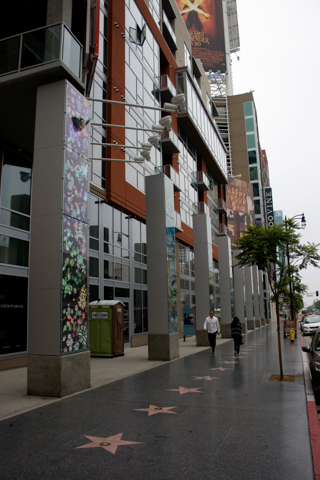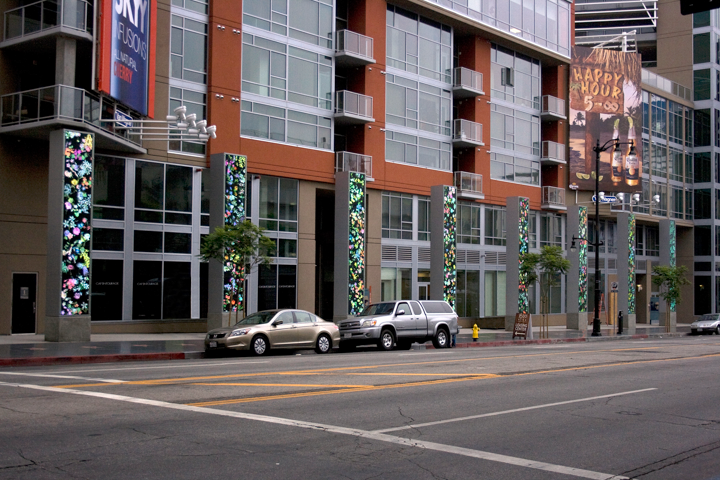|
Orson Wells
Citizen Kane, 1941
Often hailed as one of the greatest Hollywood films of all time, and Orson Welles' greatest achievement, Citizen Kane follows the life and career of newspaper magnate Charles Foster Kane. The opening scene portrays the final minutes of Kane's life, as he lays dying, clutching a snow globe, in his grandiose pleasure palace, Xanadu. With his last breath he utters the word "Rosebud," as his snow globe crashes to the floor. The film proceeds with flashbacks to Kane's life, slowly unraveling the mystery of his final word. In addition to the elusive central theme of "rosebud," flowers are used imaginatively throughout the film to frame shots, to establish moods and to convey time passing in pivotal scenes.
flowers: peonies, carnations, gladiolas, stephanotis, magnolias, lilies, dogwood, roses, marigolds, cornflowers, lisianthus
Art Direction: Van Nest Polglase
Set Decoration: Darrell Silvera (uncredited)
Jane Wyman and Donald Crisp
Pollyanna, 1960
Pollyanna is a Walt Disney film based on the classic 1913 novel by Eleanor H. Porter which tells the story of an orphan girl who moves to a small town to live with her wealthy but stern Aunt Polly (Jane Wyman). Pollyanna's sunny disposition and infectious optimistic philosophy of seeing the good in every situation, what she calls "The Glad Game," gradually touches the lives of the dour, feuding townspeople one-by-one. After a tragic accident in which Pollyanna loses the use of her legs, she is for the first time dispirited and pessimistic. The entire town gathers at her house with flowers and gifts to lift her spirits and sing her praises. Even the austere Aunt Polly is touched by this public outpouring of affection and her demeanor is completely transformed, appearing in the final scene dressed in brilliant shades of pink and white, and a hat full of flowers (giant roses and peonies). The story concludes as Pollyanna regains her cheerful optimism and leaves town for an operation to correct her paralysis.
flowers: gladiolas, tiger lilies, geraniums, lilies, oleandesr, chrysanthemums, begonias, carnations, dahlias, zinnias, irises, roses, daisies, petunias
Art Direction: Carroll Clark and Robert Clatworthy
Set Decoration: Emile Kuri and Fred M. MacLean
Audrey Hepburn
My Fair Lady, 1964
Based upon George Bernard Shaw's Pygmalion, My Fair Lady tells the story of a bet made between Henry Higgins, a professor of phonetics, and his colleague Colonel Pickering, that through proper training in diction and etiquette Higgins could transform a dowdy Cockney flower girl, Eliza Doolittle (Audrey Hepburn), into a refined, aristocratic, Victorian lady. Higgins ultimately wins this bet when Eliza Doolittle makes a thoroughly convincing appearance at the Embassy Ball. Following the ball, Higgins boasts of his successful experiment, leaving Doolittle feeling used and abandoned, prompting her to leave with Freddy Eynsford-Hill, who has fallen madly in love with her. Higgins and Doolittle are ultimately reunited once Higgins comes to the realization he has "grown accustomed to her face." My Fair Lady presents in brilliantly saturated Technicolor is a floral feast for the eyes, comprised of daisies peonies, carnations, roses, mums, phlox, stock, amaryllis, azalea, spider mums, lilacs, anemones, hydrangea, tulips and, most importantly, violets, the flower Eliza originally peddled.
flowers: phlox, azaleas, spider mums, tuber rose, lilies, roses, chrysanthemums, stock, lilacs, violets, carnations, daisies, peonies
Art Direction: Gene Allen and Cecil Beaton (uncredited) (both shared an Oscar)
Set Decoration: George James Hopkins
Cary Grant
Philadelphia Story, 1940
The Philadelphia Story is a screwball romantic comedy adaptation of Philip Barry's hit Broadway play. Tracy Lord (Katherine Hepburn), an aristocratic heiress in Philadelphia who left her playboy husband C.K. Dexter Haven (Cary Grant) is on the verge of a second marriage to self-made millionaire George Kittredge. The plot thickens when her ex-husband Dexter appears on the eve of the wedding with a reporter (James Stewart) and a photographer from Spy Magazine in tow. As the wedding approaches, Tracy's romantic inclinations waver between her fiance, her ex-husband, and the reporter. As the film centers around an impending wedding, wedding flowers such as roses, babies breath, carnations, lilies, anthuriums, gladiolas, hollyhock, and daffodils are abundant throughout.
flowers: gladiola, hollyhock, easter lilly, rhododendron, peonies, lily, carnation, chrysanthemum, geranium, gardenia, roses, daffodils, iris
Art Direction: Cedric Gibbons
Set Decoration: Edwin B Willis
Donna Reed
It's a Wonderful Life, 1946
Frank Capra's holiday classic It's a Wonderful Life is an offbeat take on Dickens' A Christmas Carol. It tells the story of George Bailey, a man who has spent his lifetime giving up on his own dreams in order to support his community, the small town of Bedford Falls. On Christmas Eve, Bailey is suicidal over the possible demise of his loan business and his own personal financial ruin. At his darkest hour, George is visited by a guardian angel named Clarence who shows him what life in Bedford Falls would be like if George Bailey had never been born. Upon witnessing these dystopian visions, Bailey realizes the good things he had in life and asks his angel to let him live again. His return to reality is only confirmed when he reaches into his pocket and discovers rose petals he had earlier received from his daughter.
flowers: holly, frankincense, chrysanthemums, azaleas, begonia, iris, hibiscus, hollyhock, dogwood, gardenia, carnation, gerbera daisy, zinnia, daisy, violet, roses, poinsettia
Art Direction: Jack Okey
Set Direction: Emile Kuri
Margaret O'Brien
Little Women, 1949
Little Women is an MGM adaptation of Louisa May Alcott's classic novel. It is a coming of age story about four young sisters, Jo, Beth (Margaret O'Brien), Amy, and Meg, who must overcome adversity and grow into womanhood while their father is away, serving for the Union Army during the Civil War. A plethora of flowers can be found throughout the film, typically used to illustrate key events and frame the passing of time.
flowers: holly, geranium, lily, dogwood, hibiscus, phlox, chrysanthemum, zinnia, roses, sunflowers, gardenia, daisies, cineraria, gerbera daisies, lilacs, pansies
Art Direction: Cedric Gibbons, Paul Groesse
Set Decoration: Edwin B Willis
William Bendix
The Blue Dahlia, 1946
The Blue Dahlia is a classic noir film written by Raymond Chandler, with scenes filmed on Vine Street in this part of Hollywood. Johnny Morrison (Alan Ladd) returns home from the Navy with his pal Buzz (William Bendix) to find his wife in the arms of Eddie Harwood, the owner of the Blue Dahlia nightclub. When Johnny's wife is later found murdered, he discovers he is the prime suspect. Johnny teams up with Harwood's estranged wife, femme fatale Joyce Haywood (Veronica Lake), to elude the police and clear his good name.
flowers: dogwood, delphinium, carnation, azalea, geranium, lilies, roses, sweet william, dahlias, clematis, primrose, pansies
Art Direction: Hans Dreier and Walter Tyler
Set Decoration: Sam Comer and Jimmy Walters
Ray Milland
Dial M for Murder, 1954
Dial M for Murder is a classic suspense thriller directed by Alfred Hitchcock. Former pro-tennis player Tony Wendice (Ray Milland) plots to have his wealthy wife Margo (Grace Kelley) murdered when he learns that she is having an affair with a crime writer (Robert Cummings). The plot thickens when Margo manages to escape an attempt made on her life and kills her attacker in self-defense with a pair of scizzors. Quickly improvising a response to this turn of events, the husband struggles to recast the story and frame his wife for murder. Of all the flowers that appear in this film, narcissus features most prominently, carefully framing acute moments of egotistical behavior.
flowers: glory lilies, tuber rose, violets, lilies, trumpet vine, carnation, peonies, gerbera daisies, lilacs, roses, daffodils, gardenias, ranunculus
Art Direction: Edward Carrere
Set Direction: George James Hopkins
|










